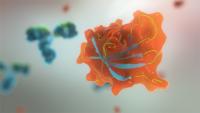A new study (link is external) published demonstrates the power of Affimer technology in interpreting protein-protein interactions and highlights their potential as research reagents in drug discovery and as therapeutics. Researchers at the University of Leeds employed a library screen of Affimer binders to investigate the protein-protein interactions that occur between the pharmaceutically relevant HIF-1? and its coactivator protein p300.
Most solid tumours develop regions of hypoxia as they grow and outstrip their blood supply. In order to survive in the stressful hypoxic environment tumour cells have developed a coordinated set of responses. The HIF-1?-p300 transcription factor complex is a critical mediator of this, upregulating the expression of proteins that promote angiogenesis, anaerobic metabolism and many other survival pathways. The outcomes of the cellular responses to hypoxia are aggressive disease, resistance to therapy and decreased patient survival.
Inhibiting this pathway through the inhibition of HIF-1? binding to p300 to prevent transcriptional activity is therefore an attractive target for cancer therapy. Yet, it has proven difficult to achieve with small molecule inhibitors as the interfaces of protein-protein interactions are generally large and lack well-defined pockets in comparison to enzyme active sites.
The team at Leeds University approached this problem by assessment of the molecular regions that make up the interface between HIF-1? and p300. They utilised the opposing yet complimentary experiments of analysing the binding of short native HIF-1? peptides to p300 and the mutation of key residues within the p300 HIF-1? binding pocket to demonstrate that helix 3 is the most important of the helical regions of HIF-1? in terms of affinity for p300.
Phage display technologies can be used to present many different forms of binder. In this study the authors used two different phage display approaches. One utilised commercial phage display libraries, which showed similar low affinities for p300 as the native HIF-1? peptides. The peptide identified from the commercial library was discovered to bind within the HIF-1? helix 3 binding pocket of p300, as it showed reduced affinity binding to the p300 forms mutated in this binding pocket compared to the wild type. Affimer binders were the second phage display technology they used to examine HIF-1?-p300 interactions.

Affimer reagents and biotherapeutics are engineered non-antibody binding proteins, which mimic the molecular recognition characteristics of antibodies, but with improved properties (small, monomeric, thermostable, soluble and easy to express in E.coli and mammalian cells giving high protein yield). The Affimer library has two randomised loops of 9 residues which are suitable for molecular recognition and are expected to adapt to form appropriate molecular contacts with a wide range of targets including protein pockets, protein surfaces, peptides and small molecules.
The highest affinity Affimer selected from the library showed greater affinity to p300 than both the commercially derived phage display-derived peptides and the shorter native peptide sequences of HIF-1?. Additionally, all three Affimer reagents selected from the library for analysis were able to inhibit the interaction between HIF-1? and p300, with IC50 vales in the region of 1-5?M, significantly better than the HIF-1? fragments and the phage-derived peptides, which were unable to disrupt the interaction. Co-crystallisation of the Affimer with its p300 binding partner showed that neither of the variable loops of the Affimer bind to the helix 3 binding pocket of p300, and modelling studies suggest the two Affimer loops bind in different proximal crevices elsewhere on the target. The interface of the Affimer-p300 interaction is estimated to be smaller than that of HIF-1? helix 3 binding in the p300 helix 3 binding pocket and is able to inhibit the interaction between HIF-1? and p300, thus offering a potential model for the development of future therapeutics targeting this pathway based upon the pharmacophore of the two Affimer loops.